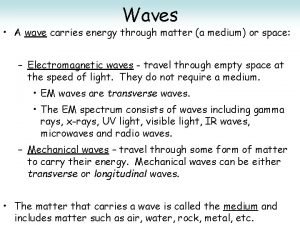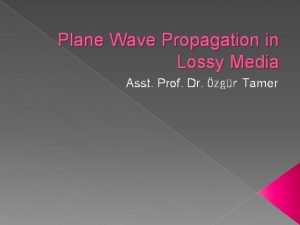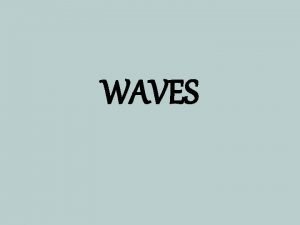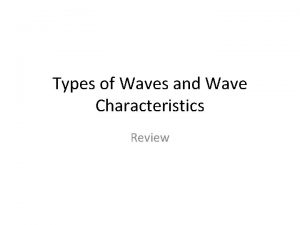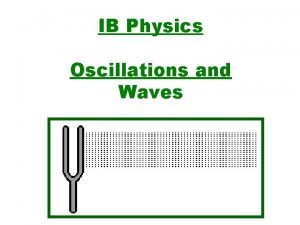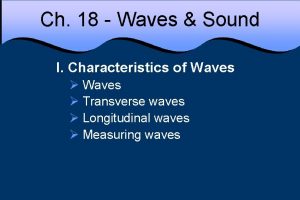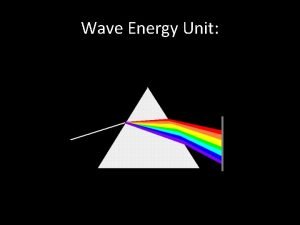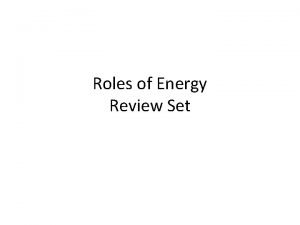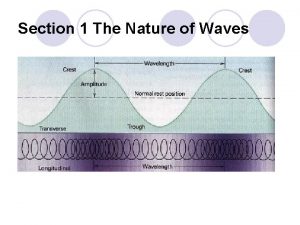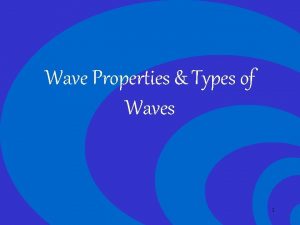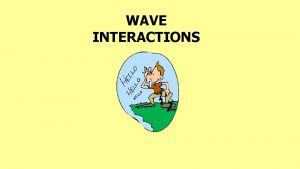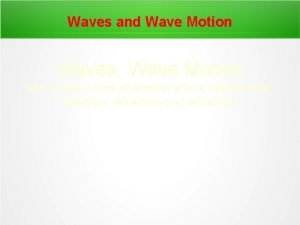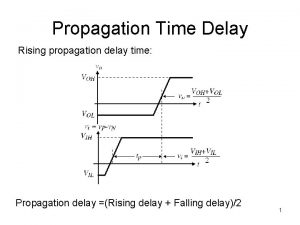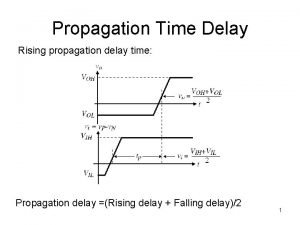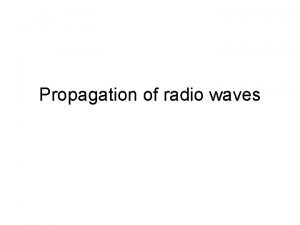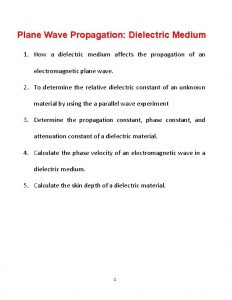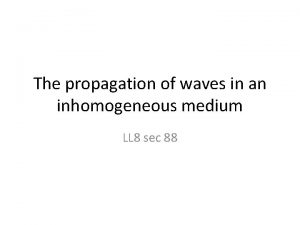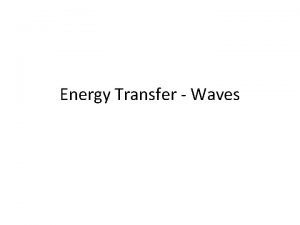WAVES Wave propagation of energy through a medium





























- Slides: 29

WAVES

Wave – propagation of energy through a medium. • Speed is determined by the properties of the medium. Gravity waves – sufficiently large waves where gravity acts as the restoring force (force that causes the water to return to its undisturbed level) Ripple (or Capillary) waves – surface tension acts as the restoring force

Wind is the most common generating force • Capillary waves are formed and grow to form gravity waves.

Fetch – continuous area of water over which the wind blows in essentially the same direction.

Anatomy of a Wave

Measures of a Wave Period – the time required for two successive crests or troughs to pass a point. (depends on the generating force) Wave Speed: speed = length of wave C= L/T wave period C = celerity (wave speed) L = wavelength T = Period

Dispersion – faster waves move through slower waves (Sorting) • Long period, Long wavelength = Greater Speed • Short period, short wavelength =Lesser Speed Wave trains = faster waves; packets of similar waves with the same period & speed Swell = faster, longer period waves; uniform, free waves

Wave Interaction When waves meet, they pass through each other and move on. • Constructive Interference – waves meet crest to crest, reinforcing one another (LARGE AMPLITUDE) • Destructive Interference – waves meet crest to trough, cancelling one another (SMALLER AMPLITUDE)


Wave Height- The height of a wave is controlled by the interaction of several factors: 1. Wind speed 2. Wind duration 3. Fetch 40 -50° latitude – roaring forties/furious fifties Ideal for the production of high waves… • No landmasses to interfere • High intensity storms • Strong winds of long duration (westerlies)

Episodic (Rogue) Waves • Large waves that suddenly appear, unrelated to local sea conditions • Abnormally high wave that occurs because of a combination of intersecting wave trains, changing depths and currents • Occur most frequently near the edge of continental shelves (200 m deep) and in certain areas with prevailing wind, wave & current patterns • Heights: 7 to 8 stories high (1/2 mile λ)

Episodic (Rogue) Waves North Sea ~ 33. 8 meters (111 feet) http: //www. youtube. com/watch? v=ur. P 3 k. T 6 d. Ctk Algulhas current area ~ 57. 9 meters (190 feet)

More Rogue Waves… • http: //www. youtube. com/watch? v=Wt. Gi 42 nxu 8 s Rogue wavehttp: //www. youtube. com/watch? v=y. Lzgzv. Vx. UV 4

Wave Steepness = Height Length S=H L There is a maximum possible height for any given wavelength. • If the ratio exceeds 1: 7, the wave breaks • Whitecaps – short wavelengths (1 m), wind increases their height rapidly.

Shallow Water Waves • As waves enter shallow water, they “feel” the bottom and friction reduces the forward speed of the wave • Speed reduction = wavelength reduction = increased height • The wavelength and speed are controlled by water depth.

Refraction • As waves move from deep water to shallow, they bend or refract. • Result: change wavelength and speed

Refraction


Reflection • Waves bounce off of cliffs, steep beaches, breakwaters, bulkhead or other structures that are straight. • Waves passes through incoming waves to produce an interference pattern.


Diffraction • The spreading of wave energy sideways to the direction of wave travel. • After they pass the barrier, crests decrease in height and energy is transported sideways.

Diffraction http: //www. youtube. com/watch? v=IZg. Yswtwl. T 8

The Surf Zone • Shallow area along the coast in which the waves slow rapidly, steepen, break and disappear in turbulence • If shallow water depths extend offshore for some distances, the surf zone is wider than over a sharply sloping shore. • Longer, higher waves become unstable and break farther offshore Breakers – breaking waves

The Surf Zone Plungers – break with a sudden loss of energy and a splash. • Form on narrow, steep beach slopes Spillers – less dramatic wave form consisting of turbulent water and bubbles flowing down the collapsing wave face. • Form over wider, flatter beaches where energy is extracted more slowly over shallow bottom • Spillers give surfers a longer ride, but plungers give a more exciting one

Tsunamis Tsunami ~ seismic sea wave; Japanese word meaning “harbor wave. ” • When the earth’s crust suddenly is moved up or down, it causes the sea surface to move as well. • Long wavelength (100 -200 km; 60 -120 miles) • Tsunamis are shallow water waves because the depth of the ocean (4000 m; 1300 ft) is less than 1/20 th the wavelength • Velocity = 200 m/s (400 mph)


Tsunamis • When a tsunami first forms, height = 1 -2 m but this height is over many kilometers. • Energy is distributed from the surface to the floor over the length of the wave • As it reaches the coast, it slows (50 mph), its wavelength decreases, and energy is compressed into a smaller water volume. • Result: wave height builds rapidly • Loss of energy is rapid when wave breaks.

Tsunamis

 What waves do not require a medium
What waves do not require a medium Wave propagation in lossy dielectrics
Wave propagation in lossy dielectrics Hot and cold definition
Hot and cold definition Vydj
Vydj Medium waves
Medium waves Mechanical waves and electromagnetic waves similarities
Mechanical waves and electromagnetic waves similarities Sound waves from a radio generally travel in which medium
Sound waves from a radio generally travel in which medium Lrefraction
Lrefraction Toh
Toh What waves don't require a medium
What waves don't require a medium Characteristics of a longitudinal wave
Characteristics of a longitudinal wave What are waves
What are waves Mechanical waves examples
Mechanical waves examples Light is electromagnetic radiation true or false
Light is electromagnetic radiation true or false Mechanical and electromagnetic waves similarities
Mechanical and electromagnetic waves similarities Mechanical waves and electromagnetic waves similarities
Mechanical waves and electromagnetic waves similarities What type of waves are sound waves? *
What type of waves are sound waves? * Is echolocation transverse or longitudinal
Is echolocation transverse or longitudinal What is a semiconductor used for
What is a semiconductor used for Difference between matter waves and electromagnetic waves
Difference between matter waves and electromagnetic waves Mechanical vs electromagnetic waves
Mechanical vs electromagnetic waves Mechanical and electromagnetic waves similarities
Mechanical and electromagnetic waves similarities Surface waves and body waves
Surface waves and body waves Seismic waves are mechanical waves
Seismic waves are mechanical waves Compare and contrast p waves and s waves using venn diagram
Compare and contrast p waves and s waves using venn diagram Mechanical waves and electromagnetic waves venn diagram
Mechanical waves and electromagnetic waves venn diagram Constructive
Constructive As nutritional energy passes through the food chain, energy
As nutritional energy passes through the food chain, energy Ability of two or more waves to combine and form a new wave
Ability of two or more waves to combine and form a new wave Difference between full wave and half wave rectifier
Difference between full wave and half wave rectifier
